An artist’s impression of Mars Express. The spacecraft left Earth for Mars on June 2, 2003. It reached its destination after a six-month journey, and has been investigating the planet since early 2004. Credit: ESA – D. Ducros
Mars appears in the night sky different from all the other gleaming dots in the darkness. Look carefully and even to the naked eye it has an orangey hue, look even closer and there’s a twenty-year-old spacecraft that has been lovingly circling it for two decades. Peering down on Mars’ familiar but eerily lifeless surface, Mars Express has re-written our view of a planet that perhaps once looked more like our own home, and where we plan to set foot soon.
The Mars Express spacecraft, launched by the European Space Agency in 2003, has far exceeded its planned lifespan, offering significant insights into Mars’ geological and atmospheric characteristics, and finding evidence of water ice on and beneath the surface. Despite technical challenges, the mission team has kept the spacecraft functional, helping with other missions like NASA’s Phoenix and Mars Science Laboratory missions. The mission will continue until at least 2026.
Mars ‘Express’ was given its name because it was built and launched in record time and at a much lower cost than previous, similar missions, but nothing else about it has gone by fast. In every way, Mars Express has outlived, outperformed, and indeed surpassed expectations.
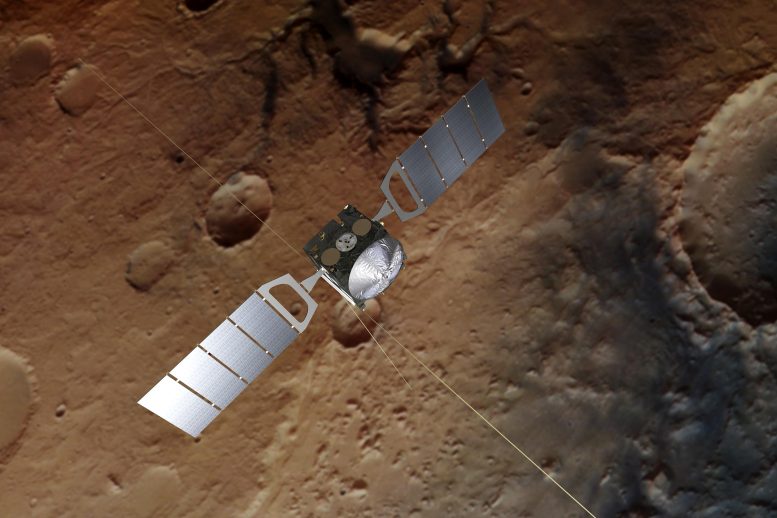
Artist’s impression of Mars Express. The background is based on an actual image of Mars taken by the spacecraft’s high resolution stereo camera. Credit: Spacecraft image: ESA/ATG medialab; Mars: ESA/DLR/FU Berlin
In human years, Mars Express would now be very old, having survived five times longer than it was designed for. While it may be feeling its age, it continues to lift the lid on the Red Planet, with implications for our understanding of our own home.
Happy Birthday, Mars Express.

Mars Express, launched on June 2, 2003, at 23h45 (local time) on board a Soyuz-Fregat rocket from the Baikonur Cosmodrome in Kazakhstan. Credit: ESA/STARSEM-S. CORVAJA 2003
Mars Express: watershed moments
Launched on June 2, 2003, from the Baikonur Cosmodrome in Kazakhstan, Mars Express began Europe’s first journey to explore our crimson neighbor and indeed any other planet. Carrying a suite of scientific instruments, the spacecraft aimed to study Mars’ geology, climate, and atmosphere, providing valuable insights into its history and potential for hosting life
One of the mission’s most significant achievements was the successful arrival at Mars on December 25, 2003, when the spacecraft skilfully entered orbit around the planet – no easy feat. Captured by Mars’ gravity, a window opened up for us to capture breathtaking images of the Martian surface and changing weather patterns, revealing diverse landscapes from towering volcanoes to deep valleys and ancient riverbeds.

The HRSC on ESA’s Mars Express obtained this perspective view on February 2, 2005, during orbit 1343 with a ground resolution of approximately 15 meters per pixel. It shows an unnamed impact crater located on Vastitas Borealis, and in its center, water ice. Credit: ESA/DLR/FU Berlin (G. Neukum),
High-resolution imagery from the German Aerospace Center’s (DLR) HRSC instrument continues to provide scientists with invaluable data, enabling them to reconstruct the planet’s geological history and shed light on its potential for life, past or present.
But it is not just the images that have shaped our understanding of Mars. Mars Express’s radar instrument, MARSIS, has been instrumental in detecting water ice above and hidden beneath the planet’s surface and the OMEGA instrument, in one of MEX’s earliest discoveries, found exposed water ice in the polar ice caps.
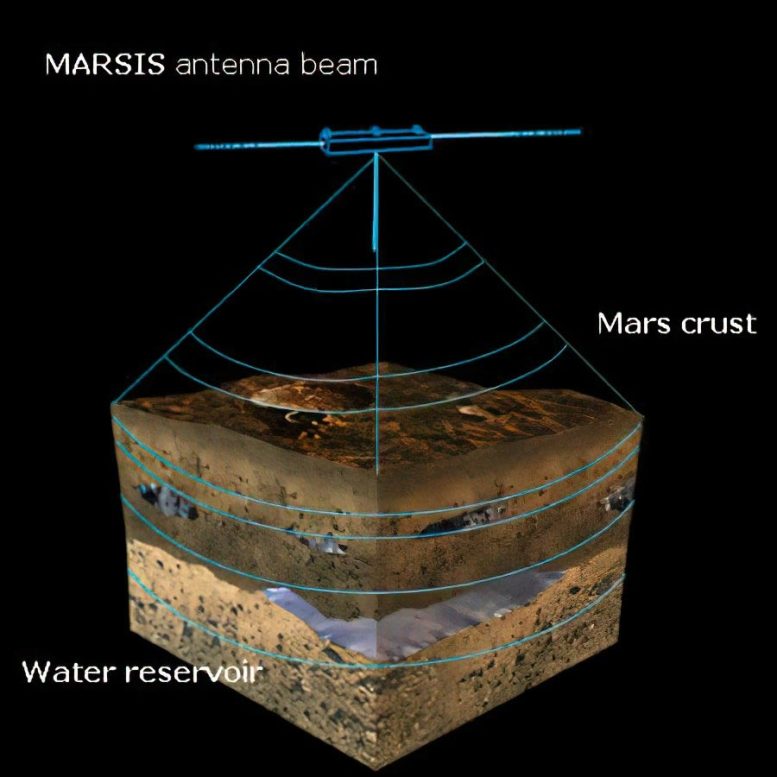
For decades, astronomers wondered about water on Mars. Thanks to Mars Express, much of the speculation has been replaced with facts. The MARSIS instrument has shown that many of Mars’ upper layers contain water ice, as well as abundant water ice in polar regions – reservoirs or ice never seen before. Credit: ESA
Even more exciting, was the MARSIS discovery of signs of liquid water hidden beneath layers of ice in arctic regions and “reminiscent of Lake Vostok, discovered some 4 km below the ice in Antarctica on Earth”.
These findings have far-reaching implications. As water is a vital ingredient for the existence of life as we know it, Mars Express has sparked further interest in future missions to the Red Planet, focused on exploring the possibility of past or present microbial life.
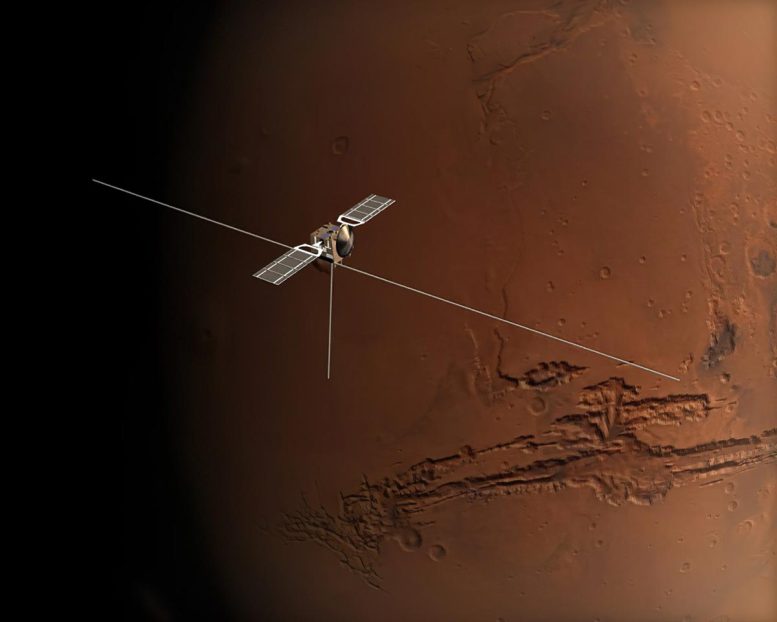
This is an impression of the completely deployed MARSIS experiment on board ESA’s Mars Express orbiter. Its two 20-meter booms and the 7-meter booms are sprung out and locked into place. Credit: ESA
The mission with many more than nine lives
Mars Express’ longevity is no accident. Its long life and years of ‘extra’ science are thanks to the robust design of the spacecraft and to the ingenuity and dedication of the mission operations team at ESA’s mission control in Darmstadt, Germany, the science operations team at ESAC in Madrid, Spain, and the scientists and industry partners across Europe who have helped to keep the mission flying long past its planned nominal lifetime of one Martian year (687 Earth days).
Together, ‘MEX’ engineers and scientists have overcome a staggering number of problems from hundreds of millions of kilometers away.
Shortly after launch, a problem with Mars Express’ solar array wiring led to only 60% of the expected power being available. This setback required the control team to develop an entirely new mission concept within the six months it took to reach Mars, adjusted the power settings, and managing to increase it to around 70%.

Hubble spots Mars Express’s cosmic bully, Siding Spring. Credit: ESA
On its way to Mars, the spacecraft was also recovered from several Safe Modes, and during the deployment of the MARSIS radar boom, the first part became stuck. The team had to devise a solution to warm it up and successfully release it – we feel you, Juice.
In 2011, Mars Express encountered a mass memory problem that resulted in the loss of its long-term memory storage capabilities. In response, teams developed a new operational concept using the spacecraft’s short-term memory storage, which required finding a way to fit 3000 ‘telecommands’ into a queue that could only hold 117 – which they did.
As the spacecraft’s batteries also aged over time, the mission control team implemented increasingly elaborate power-saving measures to maximize its longevity – by optimizing power consumption and usage they made Mars Express one of the most efficient vessels to leave Earth.
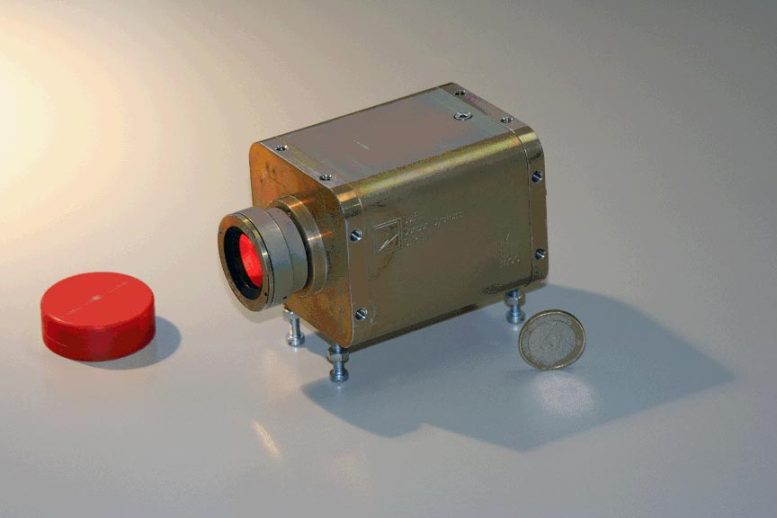
The Visual Monitoring Camera (VMC) underwent significant modifications and improvements, transforming it from a mere engineering camera to a fully operational science instrument. This rehabilitation allowed for valuable scientific observations and image capture during the mission. Credit: ESA
Dramatically in 2014, Mars Express had to navigate a close encounter with comet Siding Spring. Although the comet would miss Mars and its orbiter, particles in its tail would be traveling at a staggering 56 km/second! Engineers protected the mission from this darting dust by adjusting its orbit and using Mars itself as a shield, while also managing to gather science observations of the unique moment a comet flew by a rocky planet.
And in 2018 MEX led the way in being the first ESA spacecraft to go ‘gyroless’. Often, the most lifetime-limiting part of aging spacecraft is the gyros (short for gyroscopes) –rapidly spinning units that tell a spacecraft which way round it’s facing in space. The mission’s Flight Control Team five years ago reprogrammed the spacecraft so that the gyros could be turned off for extended periods, relying only on star cameras to calculate its orientation and likely extending the usable life of the mission by 10 years.
Despite all of this (and more), Mars Express has lived 18 years longer than planned. It even, in an unheard move for a spacecraft already in orbit, grew a new instrument – the ‘Mars Webcam’! It’s MELACOM lander relay radio was repurposed to probe the Martian atmosphere with ESA’s ExoMars Trace Gas Orbiter, and importantly, it has been a huge help to the whole community of science missions at Mars, playing a vital role in supporting the landings of NASA’s Phoenix mission in 2008 and the Mars Science Laboratory mission, which carried the Curiosity rover in 2012.
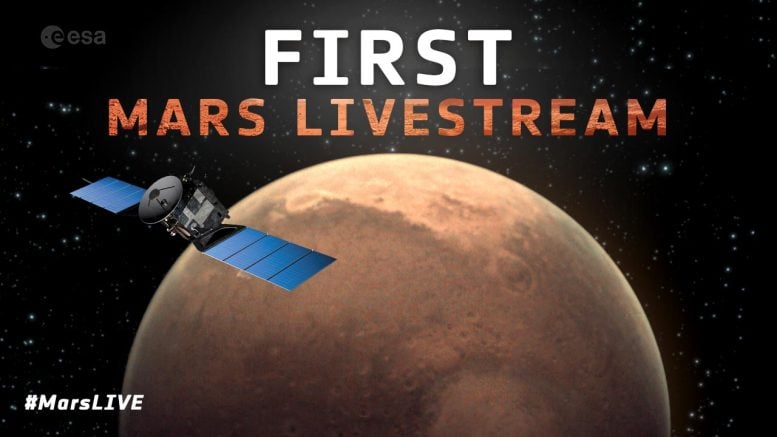
On June 2, 2023, “live” images were streamed down from Mars Express’s VMC and streamed via ESA’s Youtube channel for the first livestream from Mars. Credit: ESA
More Mars Express
Mars Express’ life has been extended multiple times, and it’s no wonder. The mission will continue its exploration of the Red Planet until at least 2026, as announced just this year in the latest mission extension.
The enduring success of Mars Express also provides valuable lessons for upcoming missions including the ExoMars rover and sample return missions, as well as more opportunities to support partners through data relay and communication support, including NASA’s Mars Sample Return campaign.
Orbiting millions of kilometers away from Earth, Mars Express continues revealing secrets of Mars – a planet that may once have harbored life and is set to become a future home for humankind. This exploration is a foundation for our continued exploration of the Solar System, and a precious chance to look back at our own planet, understand its potential future, and ensure it remains the swirling blue and green dot it is today.